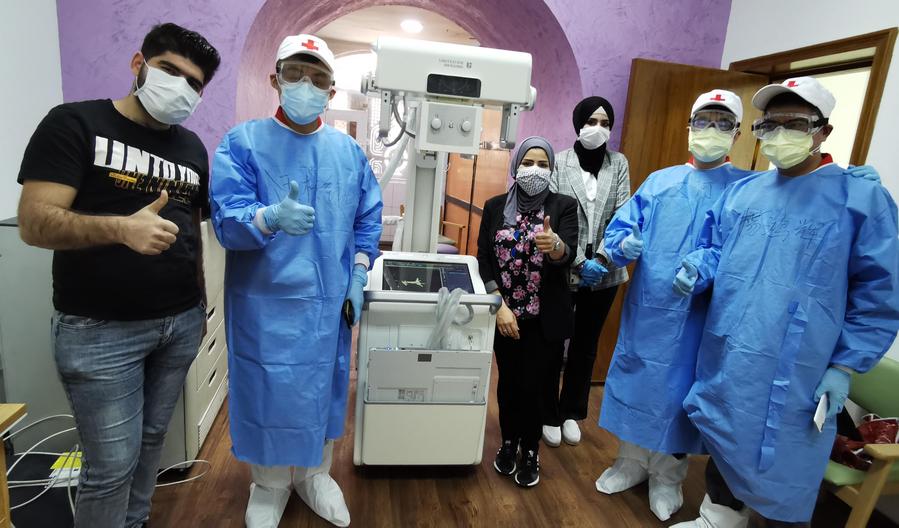Innovation spurs Chinese tech firms' earnings in global market

Cellphone photo taken on March 19, 2020 shows experts from Shanghai-based United Imaging Healthcare Co., Ltd. posing for photo with local medical workers after installing a transportable CT scanner in Baghdad, Iraq. (Xinhua)
BEIJING, Oct. 11 (Xinhua) -- It took Chinese entrepreneur Zhang Junbin eight years to transform a small startup with just 200,000 yuan (about 28,272 U.S. dollars) in initial capital into a unicorn enterprise that now sells smart robot vacuums and mops in over 30 overseas markets.
Driven by a commitment to excellence, Zhang, founder and CEO of Shenzhen-based Narwal Robotics, today leads a company of over 1,000 employees, a remarkable achievement considering its humble start in 2016 with fewer than 10 staff members.
PURSUING INNOVATION
Narwal did not launch a single product in its initial three years. Instead, it invested all of its resources into technology and product R&D, focusing on the details. The materials that had to be designed for the company's robot mop alone were selected and improved dozens of times. This slow progress threatened the firm's survival to a point.
"At that time, life was very stressful, funding was scarce and the team was understaffed. Six or seven of us squeezed into a 20-square-meter office, each earning just over 1,000 yuan a month. But we gritted our teeth and persevered for over two years before finally producing a prototype," Zhang said.
Their patience eventually paid off. During China's Double Eleven online shopping festival in 2019, their debut product saw a sales boom, achieving 10 million yuan in sales in a single day and making the company famous overnight. The next year's Double Eleven festival saw Narwal's sales exceed 200 million yuan, putting the firm on a stable earnings trajectory.
The company says that a small Narwal robotic sweeper machine involves more than 600 technology patents, and that its relevant technologies cover such areas as SLAM (Simultaneous Localization and Mapping), 3D sensing, AI object recognition and big data applications.
Zhang is not alone in gaining fame in the pursuit of innovation. Xue Min, founder of Shanghai United Imaging Healthcare Co., Ltd., has followed a similar path in launching a company from scratch, growing it gradually into a formidable player in the global high-performance advanced medical imaging market.
Just over a decade ago, high-end medical imaging equipment from Chinese manufacturers was nearly nonexistent in the country's top-tier hospitals. Foreign giants like GE HealthCare, Philips and Siemens dominated more than 90 percent of the Chinese market.
"If the core technology is not in your own hands, you will always be dependent on others," said Xue.
In 2011, United Imaging was established. Its immediate goal was to produce the first domestically manufactured PET/MR (Positron Emission Tomography/Magnetic Resonance) imaging device.
Its team undertook a series of arduous tasks: dissecting basic components and cables, studying their structures meticulously using X-ray machines, and examining the diameter and material of each copper wire.
In 2018, United Imaging's first domestic integrated PET/MR device was approved and launched, making China the third country in the world that could manufacture a PET/MR system independently.
For years, the new installation volume of product lines from United Imaging has consecutively ranked first on the domestic market, leading foreign manufacturers of peer products to drop their prices.
Zhang and Xue and the companies they lead epitomize Chinese firms' growing investment in technological and product R&D in recent years, which translates into growing corporate innovation strength in China.
Data from the China National Intellectual Property Administration shows that by the end of 2023, the number of companies in China holding valid invention patents had reached 427,000, an increase of 72,000 from the previous year. Of the valid invention patents in the country, domestic enterprises account for nearly 3 million, or 71.2 percent of the total.
AIMING FOR OVERSEAS MARKETS
Narwal and United Imaging represent a cohort of Chinese companies that are earning increasing revenues from foreign markets.
In 2022, Narwal decided to test the waters of the global market. In its typical fashion, the company had waited roughly three years to reach this decision, remaining quiet between 2019 and 2021 -- a peak period when many domestic robotic vacuum companies rushed into overseas markets.
"We aim to be a patient company," Zhang said, emphasizing that Narwal had used the three years to conduct market research abroad -- researching how the robotic vacuum's brush would remain untangled when used on pet hair in the European and U.S. markets. Through its precise understanding of user needs and by building on its existing technological accumulations, Narwal developed and launched a product for the overseas market that is capable of collecting hair at one end of the roll brush and sucking it into the machine.
Company data shows that by the end of July this year, Narwal's overseas revenue had grown nearly 7.5 times year on year, expanding the number of countries and regions where it sells products from nine last year to over 30 this year, including markets such as Italy, Sweden and the Netherlands.
And United Imaging's report for the first half of 2024 shows that the company's overseas business contributed 17.5 percent of its revenue in the period. The company is a clear example of a newcomer capable of opening new horizons in the global market with quality products.
"United Imaging has benefited from innovation and will continue to grow from it. I am very confident that in another five to 10 years, I can lead the company into the rank of a world-class enterprise," Xue said.
INSTITUTIONAL SUPPORT FOR INNOVATION
The third plenary session of the 20th Communist Party of China (CPC) Central Committee, which was held in July, made full arrangements to support comprehensive innovation through deepened reforms in the fields of education, science and technology, and talent.
In a long-term institutional arrangement, the Chinese government has increased tax deduction support for eligible firms engaged in R&D, allowing them to reduce their corporate income tax payments by deducting another 100 percent of their R&D expenses. The People's Bank of China, the country's central bank, has relending facilities for commercial banks, encouraging them to increase financial support for small and medium-sized tech firms.
According to Huang Kunming, a member of the Political Bureau of the CPC Central Committee and secretary of the CPC Guangdong provincial committee, building a mechanism that supports comprehensive innovation is a practical requirement to achieve high-level scientific and technological self-reliance and strength, and this is key to advancing Chinese modernization.
Huang, in his article published in a study book on a resolution adopted at the third plenum of the 20th CPC Central Committee, noted that the market is the best incubator, accelerator and amplifier of innovation, and that full play should be given to the market's guiding role in the direction, route selection and resource allocation of R&D so that new technologies, products and business formats that have the greatest development advantages can be selected.
Photos
Related Stories
- A glimpse into China's 75 years of innovation through intellectual property endeavors
- China to host global summit for science parks, innovation hubs in 2025
- China among fastest risers in world's most innovative economies ranking: WIPO
- China has enormous innovation capacity to spur growth: experts
- Pujiang Innovation Forum to be held in Shanghai
Copyright © 2024 People's Daily Online. All Rights Reserved.









